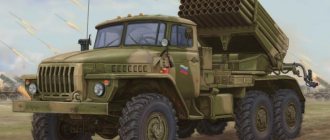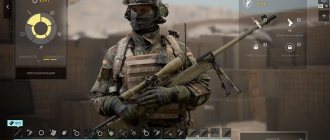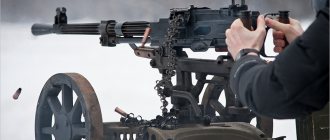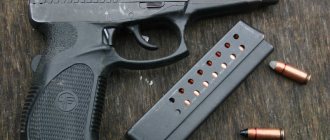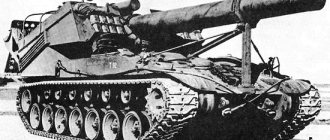At the end of the 70s. The development of a heavy flamethrower multiple launch rocket system began. The system was a installation with unguided rocket projectiles. TOS-1 "Buratino" was created on the basis of the T-72 tank. During development, the system was designated “Object 634”. TOS-1 was first used during the Afghan war. The goals of creating a heavy flamethrower installation required it to be installed on a chassis with significant carrying capacity. The designers also had to take into account the relatively low firing range and install a certain level of protection on the combat vehicle. All this significantly made the multiple launch rocket system heavier.
History of creation
It was developed in the period from 1971 to 1979 at the Design Bureau of Transport Engineering (Omsk) together with NIIFP (Zelenograd), which was responsible for on-board equipment[1]. The first prototypes on the T-72 chassis were manufactured in Omsk in 1978-1979. The complex included a combat vehicle - a launcher (BM) with a package of 30 guides on the T-72 chassis and a transport-loading vehicle (TZM) on the KrAZ-255B chassis. During development and testing, the BM had the designation “ Object 634”
" In 1980, the vehicle successfully passed state tests and was recommended for adoption by the USSR Armed Forces. It was first used in Afghanistan in 1988-1989.
Designed to disable lightly armored and automotive vehicles, set fire to and destroy structures and buildings, destroy enemy personnel located in open areas and in fortifications, by fragments, shock waves created on the target area during the massive use of unguided rockets in thermobaric and smoke incendiary equipment.
Design features and principle of operation
The large mass of the package of guide pipes with projectiles required a chassis with significant carrying capacity, and relatively short firing ranges (from 400-600 to 4500 m) required a certain level of protection for the entire combat vehicle, which again made it heavier. As a result, the mass of the combat vehicle reaches 46 tons.
A package of 30 guides for unguided rockets (NURS) is mounted in the swinging part of the launcher on a rotating platform. The crew performs all actions to point the installation at the target and give it the required elevation angle without leaving the vehicle, using a sight and power servo drives.
The steep flight path of projectiles to the target required accurate consideration of firing conditions and the creation of a special fire control system. It includes an optical sight, laser rangefinder, roll sensor and electronic ballistic computer. Using a laser rangefinder, distances to the target are determined with an accuracy of 10 meters. This data is automatically entered into a ballistic computer, which calculates the required elevation angle of the launcher. The roll angle of the guide package is recorded by an automatic sensor and is also automatically taken into account by the computer.
An unguided rocket consists of a warhead with a filler (incendiary or thermobaric composition), a fuse and a solid propellant jet engine.
The heavy flamethrower system consists of a combat vehicle with guides (BM-1) and two transport-loading vehicles (TZM-T), also created on the basis of the T-72 tank [ specify
]. TZM-T is used for transporting NURS, as well as loading and unloading a combat vehicle, and therefore is equipped with a special crane.
It was first presented to the public in 1999 in Omsk (Transmash).
"Pinocchio" and "Solntsepek" prospects
In 2000, the press around the world reported the use of new weapons by Russian troops. , the TOS-1 “Buratino” self-propelled heavy flamethrower systems fired at the militants’ positions.
.
Soon after these messages, some details began to appear regarding the technical and combat characteristics of the complex. In addition, the greater effectiveness of unguided missile strikes caused a specific reaction from some human rights activists. These people considered the TOS-1 an inhumane weapon and even began to demand that the world community condemn the actions of the Russian military. However, all foreign reaction was limited to only muted criticism and muted praise. More than ten years have passed since then, and the TOS-1 complex, together with its modernization TOS-1A "Solntsepek"
continues to be in service with Russian RCBZ troops. At the same time, the total number of heavy flamethrower systems built, according to various estimates, does not exceed two to three dozen. Why did the weapons, which received many laudatory reviews and caused a critical reaction, enter the army in such limited quantities? Let's try to figure it out.
Let's start in order. The basis of the combat vehicle of the TOS-1 and TOS-1A complexes is the tracked chassis of the T-72 main battle tank. Diesel engine V-46 with a power of 700 hp. provides the 46-ton vehicle with mobility and maneuverability at the level of other armored vehicles, which allows it to operate as part of mobile strike groups. Thus, during the already mentioned use of TOS-1 missiles against targets in the village of Komsomolskoye, the flamethrower systems were covered by T-72 tanks. Thanks to the same base and slight difference in combat weight, Buratino and tanks did not have any problems in interaction when approaching and leaving a combat position. The TOS-1A "Solntsepek" modification received a new power plant - the V-84MS diesel engine with a capacity of more than 800 horsepower. This innovation to a certain extent improved the driving performance of the combat vehicle.
As we can see, the driving characteristics of the armored combat vehicles "Buratino" and "Solntsepek", equipped with launchers, could hardly be the reason for the small number of vehicles ordered. Maybe the military’s complaints are caused by other vehicles in the complex? Probably. The original TOS-1 complex included a transport-loading vehicle (TZM) based on the KrAZ-255B truck. The wheeled chassis was equipped with a cargo crane and devices for transporting unguided missiles. It is quite obvious that the wheeled chassis of the TZM flamethrower system did not have the same speed and cross-country ability as the combat vehicle. For this reason, the modernized TOS-1A received a new transport-loading vehicle made on the chassis of the T-72 tank. The target equipment of the new TZM was modified accordingly. In addition, special armored casings were added to the design, covering the missiles from bullets and shrapnel in the stowed position. Each combat vehicle of the Buratino and Solntsepek complexes is equipped with two TZMs with a set of unguided missiles. If necessary, a formation of flamethrowers can be assigned a number of trucks to transport a supply of missiles, but in this case, for safety reasons, it is necessary to transport missiles to the combat vehicle exclusively on TZM with a closed casing.
So, all vehicles of the complex are maximally unified and protected from enemy attacks . When creating a new version of the heavy flamethrower system, a number of military wishes were taken into account, which, for example, led to a number of innovations related to the level of protection of ammunition and, as a result, vehicles. The main armament of both complexes is unguided rockets MO.101.04 and MO.1.01.04M of 220 mm caliber. Both types of missiles are equipped with a volume-detonating or incendiary warhead. The MO.101.04 projectile appeared first. With a length of 3.3 meters, it weighs more than 170 kg and has a maximum flight range of 3,600 meters. The new MO.101.04M missile is longer (3.7 meters), heavier (217 kg) and flies further, six kilometers. Missiles are launched from a package of tubular guides. Externally, it looks like a box, inside of which there are “nests” for rockets. The combat vehicle of the TOS-1 complex has 30 guides, and the TOS-1A has 24. The package of guides can be aimed in horizontal and vertical planes: the rotating mechanism is installed on the seat of the standard turret of the T-72 tank. Vertical guidance is carried out by lifting the entire package.
One of the main differences between the original and modernized versions of the flamethrower system is the different number of missile guides. The reason for this was the peculiarities of the combat use of the complex. Since the maximum launch range of MO.101.04 type missiles was relatively short, the troops immediately began to take measures regarding the safety of the vehicle and crew. A volume-detonating or incendiary warhead, if damaged on the launcher, can destroy the entire vehicle. To avoid such incidents, even during the first uses of TOS-1 in Afghanistan (late eighties), crews left the outer side guides empty. Thanks to this, relatively rare enemy fragments and bullets had almost no chance of damaging the missiles. Taking this experience into account, engineers from the Omsk Transport Engineering Design Bureau redesigned the launcher. Firstly, the “loss” of six missiles in practice did not have a significant effect on the firing efficiency. Therefore, only 24 guides were left. Secondly, the saved volume and weight were used to provide protection for the missiles. Now the outer lining of the launcher is made of armor plates and can withstand hits from a B-32 armor-piercing bullet (7.62x54 mm cartridge) from a distance of 500 meters. Thus, the combat vehicle of the TOS-1A complex is practically not at risk of destruction as a result of damage to the missile warhead by small arms or shrapnel, especially when firing MO.101.04M at maximum range. As for the protection of the chassis and crew, the projectile protection of the armored hull of the T-72 tank cannot withstand hits only from powerful cumulative and high-speed sub-caliber fin projectiles.
The version about insufficient protection of combat and transport-loading vehicles can also be crossed out. Maybe the potential buyer is not satisfied with the combat qualities of unguided missiles? You can immediately say: both satisfied and not. A salvo of the first version of ammunition - MO.101.04 - ensured the destruction of targets over an area of up to two thousand square meters at ranges of up to 3.6 kilometers. A full salvo when firing at maximum speed takes from six to twelve seconds. In terms of its effectiveness, a salvo of one combat vehicle is equal to the relatively long operation of an artillery battery. At the same time, "Buratino" and "Solntsepek" do not have a large enough range of compatible ammunition: only incendiary and thermobaric. In some cases, the effect of such combat units is insufficient, for example, if it is necessary to destroy a building. This requires a direct hit of the projectile inside the target followed by an explosion. Such features of the warheads of the MO.101.04 and MO.101.04M missiles greatly limit their range of use, although they increase the affected area. The second problem with unguided missiles was their relatively short range. 3600 meters of the first version of the MO.101.04 rocket was considered too short a range, especially in comparison with other multiple launch rocket systems. In a confrontation with a seriously armed enemy, the use of TOS-1 or TOS-1A is a rather difficult task. With proper organization of interaction between units, the enemy, even if he allows the combat vehicle to enter a position, will not allow the launch. In this regard, heavy flamethrower systems are again inferior to “classic” MLRS. Thus, the 9K58 “Smerch” complex, using a 300-mm 9M55S rocket with a thermobaric warhead, is capable of hitting targets at distances from 25 to 70 kilometers, without exposing itself to the danger of falling under return fire. At the same time, the warhead of the 9M55S missile weighs a quarter more than the entire MO.101.04M missile of the Solntsepek complex.
So, we have found the stumbling block that prevents the mass production of heavy flamethrower systems and equipping troops with them. This is a specific ammunition that does not allow for widespread use. Yes, in terms of its combat effectiveness it exceeds a number of other similar systems. But the price of this is a short firing range, the risk of catastrophic consequences if ammunition is damaged, as well as the need for serious cover at the position. All these factors seriously reduce the possible conditions for using heavy flamethrower systems. And the small range of available warheads for missiles is not conducive to frequent use. The combination of the pros and cons of the TOS-1 and TOS-1A systems allows us to roughly imagine an “ideal” situation in which the use of heavy flamethrower systems will be justified and effective. This is shelling of area targets from a relatively short distance. In addition, the attacked enemy must have relatively poor training and not have serious anti-tank weapons or artillery. Thus, the ideal task for “Pinocchio” or “Solntsepek” is to strike a camp or convoy of vehicles of a weak army or armed gangs. When using the new longer-range MO.101.04M projectiles, the general features of a hypothetical salvo remain the same.
In general, in the case of the Buratino and Solntsepek heavy flamethrower systems, we are observing a specific situation.
- An interesting and, undoubtedly, promising project in practice turns out to be rather poorly adapted to real combat operations and requires the involvement of additional forces.
- Another reason why TOS-1 and TOS-1A were not ordered in large quantities concerns the specific tactical niche of the complexes.
Of course, if necessary, it would be possible to increase the firing range of flamethrower systems. But in this case, they will “overlap” with the existing MLRS. Meanwhile, the purchase of new multiple launch rocket systems continues, which cannot be said about heavy flamethrower systems.
Thus, the only suitable tactical niche for heavy flamethrower systems remains small special operations, which require rapid deployment and instant destruction of manpower and poorly protected equipment over a relatively large area.
At the same time, the very idea of a special multiple launch rocket system for RCBZ troops is interesting and, perhaps, promising.
For example, MO.101.04 missiles can be equipped not only with a volume-detonating or incendiary warhead. On the basis of this ammunition, a special projectile can be created that carries a mixture for extinguishing fires. With this use of heavy flamethrower systems (it sounds ironic - fire extinguishing using a flamethrower system), there is no need to provide fire cover for the combat vehicle, and all the advantages are fully preserved. Similarly, TOS-1 and TOS-1A are capable of eliminating small clouds of toxic substances or similar aerosols. However, the authors of the projects for heavy flamethrower systems have not yet presented alternative projects for their use and, it seems, do not even have such plans.
But Kirill Ryabov is not entirely right and there are such plans, there are even samples that have been in production for a long time. For example, on the chassis of the “Coalition-SV” Super-howitzer, on the chassis of tanks and armored personnel carriers, and even there is an all-terrain FLOATING FIRE VEHICLE for salvo fire extinguishing.
Modifications
Sunshine
Transport-loading vehicle of the TOS-1A complex
The TOS-1A “Solntsepek” heavy flamethrower system was developed in 2001[2]. The main task of the system is to support infantry and armored formations. Main differences from the basic version[2]:
- The number of guides on the combat vehicle has been reduced from 30 to 24.
- The transport-loading vehicle is made on the basis of the T-72 main tank (in the basic modification it was placed on the chassis of a KrAZ truck)
Composition of TOS-1A[2]:
- BM-1 combat vehicle (Object 634B);
- Transport-loading vehicle TZM-T (Object 563);
- NURS MO.1.01.04 or MO.1.01.04M.
Tosochka
At NPO Splav, work is underway to manufacture a prototype of a new generation of the Tosochka heavy flamethrower system for preliminary tests. The system with improved tactical and technical characteristics will be built on a wheeled chassis[3].
In service
TOS-1A "Solntsepok" at the parade in Baku, June 26, 2013
- Russia - unknown quantity, as of 2020[4] According to other sources, at least 8 units, as of 2014[5].
- Azerbaijan - 18 TOS-1A units, as of 2018[6].
- Iraq - more than 3 TOS-1A units, as of 2020[7].
- Kazakhstan - 3 TOS-1A units, as of 2020[8].
- Saudi Arabia - unknown quantity of TOS-1A[9].
- Syria - unknown number of TOS-1A, as of 2017[10].
Service and combat use
TOS-1A of the 10th NBC Defense Regiment of the 41st Army.
In the Russian Armed Forces, TOS-1s are located in regional chemical warfare brigades, each with a battalion with nine TOS-1A Solntsepek, and in army-subordinate Russian chemical warfare regiments - a company with three combat vehicles each. In total, the troops have 72 flamethrower systems.[11]
Organizational structure in the Russian Armed Forces
- military unit 71432. 1st mobile NBC protection brigade: at least four BM-1 units and one TZM-T unit[12].
- military unit 11262. 27th separate NBC protection brigade (27 brigade): a certain number.[13]
- military unit 16383. 40th NBC Defense Regiment (40 CBZ): a number of TOS-1A “Solntsepek” systems.[14]
- military unit 41474. 70th separate flamethrower battalion (70 general units): at least two BM-1 units[15].
Combat use
During the Afghan War, from December 1988 to February 1989, two Buratino systems were used during Operation Typhoon in combat operations in the Charikar Valley and South Salang. The effect of thermobaric ammunition on targets in the mountains caused great damage to the enemy due to the mutual superposition of air shock waves and their multiple reflections from the surrounding rocks[16].
TOS "Buratino" was used in the Second Chechen War, in particular in the battles for the village of Komsomolskoye in March 2000[17]. Former commander of the federal troops in Chechnya and Dagestan during the conflict in Chechnya, Colonel General Gennady Troshev in his memoirs about[18].
Observers of the OSCE Special Monitoring Mission, designed to facilitate the de-escalation of the armed conflict in eastern Ukraine, in the fall of 2020 reported the discovery of one Buratino MLRS installation at a training ground controlled by the LPR [19][20][21][22].
An unknown number of Russian Federation TOS-1A Solntsepek are deployed in Syria[23]. Including for the protection of the Khmeimim airbase (Latakia province)[24]
Used by government forces during the liberation of Palmyra[25][26]
Applied on the territory of Nagorno-Karabakh in 2020 by Azerbaijan[27]
The Iraqi Armed Forces also used the TOS-1A “Solntsepek” installation several times during combat operations. They were first noticed in action against ISIS, in the battles for the city of Jurf Al-Sakhar[28].
Taking into account the Syrian experience
There is no doubt that the Solntsepek is one of the most popular military equipment. At the International Military-Technical Forum "Army-2018", the fire capabilities of the TOS-1A were demonstrated at the Alabino training ground on the very first day of work. With an eye on foreign demand: the TOS-1A advertising passport was approved back in 2008. In its export version, it is in service with the armies of Azerbaijan, Kazakhstan, and Iraq. This formidable weapon has already proven itself during battles between government troops and terrorists in Iraq and the Syrian Arab Republic.
On August 31 last year, at the board of the Russian Ministry of Defense, the head of the department, Army General Sergei Shoigu, emphasized that an important direction in the development of radiation, chemical and biological defense troops remains the improvement of their combat systems. Over the eight months of 2020, 30 units of modernized TOS-1A heavy flamethrower systems were transferred to them. The role of these weapons in Syria was also noted at the board: with the support of the offensive of the Syrian army, these systems destroyed more than 1,200 targets.
The experience was taken into account - since last year, units armed with heavy flamethrower systems have been included in the radiation, chemical and biological protection regiments of military districts and fleets. By the way, their crews are staffed exclusively by contract soldiers.
How effective the TOS-1A is can be observed during the daily combat training of the Russian army. Thus, in March, a tactical-special training was held in the radiation, chemical and biological defense regiment of the Western Military District.
Notes
- Tikhonov, T.2, 2010, p. 173.
- ↑ 123
Missile technology: Heavy flamethrower system TOS-1A - A prototype of a new generation heavy flamethrower system is being created in Russia
- The Military Balance 2020, p.194
- How the Solntsepek flamethrower system works (Russian). Popular mechanics. Retrieved April 12, 2020.
- The Military Balance 2020, p.183
- The Military Balance 2020, p.338
- The Military Balance 2020, p.189
- Source: Russia began supplying Solntsepok systems to Saudi Arabia (unspecified)
. Retrieved July 31, 2020. - Russia's Lethal Thermobaric Rocket Launchers: A Game Changer in Syria? (undefined)
. Retrieved July 31, 2020. - According to “Sunshine” - to every army (undefined)
.
Izvestia
(February 27, 2018). Retrieved September 13, 2020. - Exercises of NBC protection troops
- Divisions of the Western Military District's NBC protection troops as part of the final inspection (Russian). Press service of the Western Military District
(November 12, 2015). Retrieved March 27, 2020. - As part of the combined arms army of the Southern Military District in the North Caucasus, a new unit of the RKhBZ (unspecified)
.
Press service of the Southern Military District
(December 31, 2014). Retrieved September 8, 2020. - Military personnel of the Eastern Military District are mastering the modified Buratino heavy flamethrower system. Ministry of Defense of the Russian Federation.
- A. V. Strugovshchikov.
TOS-1 "Pinocchio"
(undefined)
. Belarusian State University of Informatics and Radioelectronics. Retrieved October 5, 2020. - “Pinocchio” destroys the enemy with fire and sudden changes in pressure (undefined)
. RIA News. Retrieved October 5, 2020. - Troshev G.N.
Chechen break: Diaries and memories. — 2nd ed. - M.: Time, 2009. - P. 356. - (Dialogue). — ISBN 978-5-9691-0471-6. - Jamie Prenatt.
TOS-1 Buratino (Pinocchio)/TOS-1A Solntsepek (Sun) // Katyusha: Russian Multiple Rocket Launchers 1941 - present. — Bloomsbury Publishing, 2020. — P. 88. — 101 p. — ISBN 9781472810885. - Latest news from the OSCE Special Monitoring Mission to Ukraine based on information received as of September 27, 2020, OSCE (September 28, 2015). Archived from the original on October 2, 2015. Retrieved October 2, 2020.
- Leyva, Maria
. OSCE observers discovered the Buratino multiple launch rocket system in Ukraine, RBC (October 2, 2015). Archived from the original on October 2, 2020. Retrieved October 2, 2020. - Zverev, Anton
. Deadly Russian rocket system spotted in Ukraine for the first time, Reuters (October 2, 2015). Archived from the original on October 2, 2020. Retrieved October 2, 2020. - The Military Balance 2020, p. 355
- Ivan Safronov.
Non-union situation // Kommersant Power magazine. — 2016-05-30. — Vol. 21. - P. 9. - (unspecified)
were used in the Middle East . Retrieved September 6, 2020. - TOS-1A “Solntsepok” burns militants near Palmyra: video
- Azerbaijan used the TOS-1A “Solntsepek” for the first time - Ministry of Defense of the Azerbaijan Republic | 1news.az | News
- Roblin, Sebastien
.
Russia's TOS-1: Moscow's Most Powerful Weapon of War (That Isn't Nuclear) (English), The National Interest
. Retrieved March 31, 2020. - Arabian breakthrough: Russia is pushing out the US in the Middle East arms market (Russian), RIA Novosti
(20171009T1736+0300Z). Retrieved October 9, 2020. - Charlie Gao.
Introducing What Could Be Russia's Most Deadly Urban Warfare Weapon. The National Interest (27 November 2018). Retrieved January 29, 2020. - Pinocchio lights up: Karabas's worst nightmare (Russian). Popular mechanics. Retrieved April 12, 2020.
- Robert Beckhusen.
Russia Is Showing off Its Lethal Missile-Launching Tanks (English). The National Interest (1 November 2017). Retrieved January 29, 2020.
One-piece item
We do not know the exact number of Buratins in the army, but their number is measured in units. Why is such an effective weapon not mass produced and in demand on the foreign market? The fact is that Buratino’s destiny is to participate in local conflicts and counter-terrorism operations. But precisely for such operations, it is not flamethrowers that are required, but high-precision “surgical instruments” that minimize casualties among the civilian population. In full-scale combat operations, Buratino is completely outclassed by, for example, the Smerch MLRS, which is capable of sending 12 missiles with a 100-kilogram thermobaric warhead over a distance of 90 kilometers in just 38 seconds.
The article was published in the magazine “Popular Mechanics” (No. 4, April 2006).

